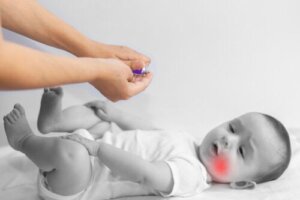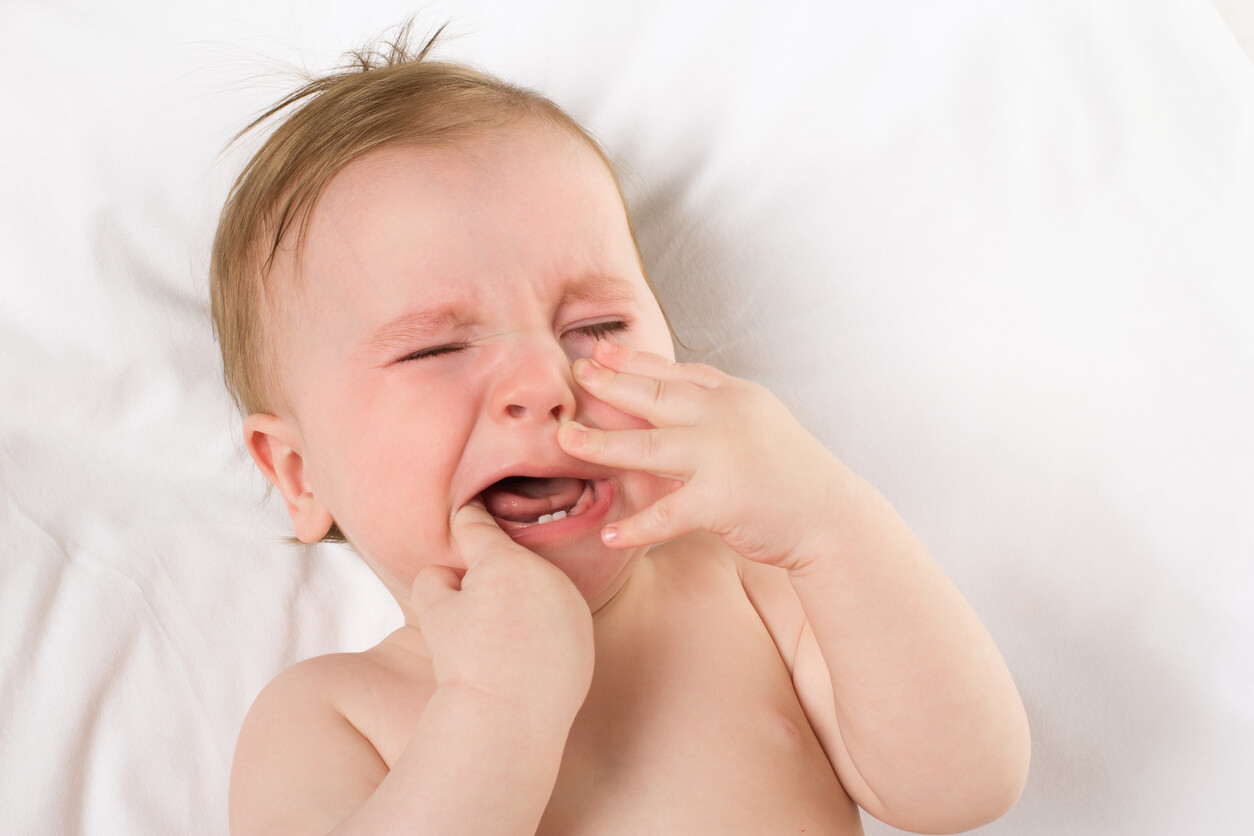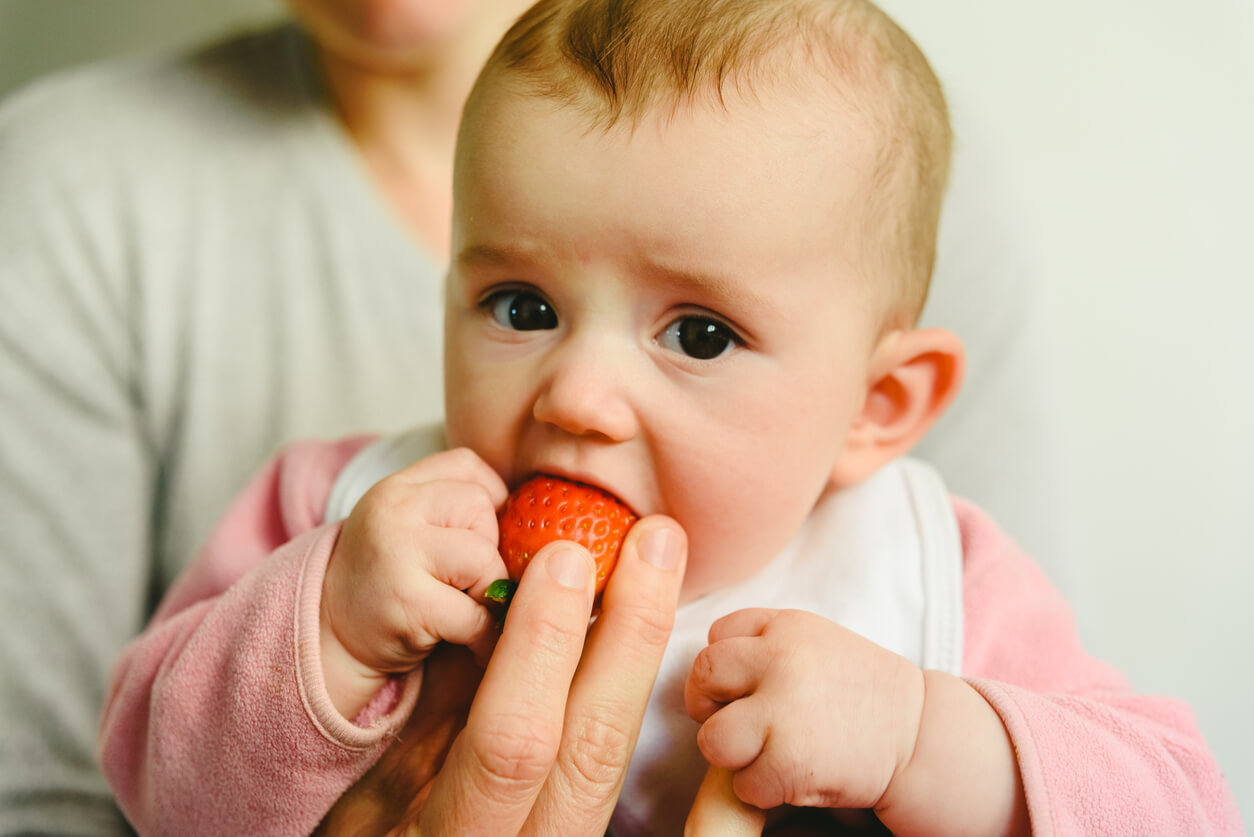Baby Gum Gel for Teething Babies

The eruption of a child’s first teeth can be a time of discomfort and anxiety for both children and parents. For this reason, some adults, in order to relieve their babies, put baby gum gel on their gums. But how safe are these over-the-counter products?
Teething time can be accompanied by crying, lack of appetite, and sleepless nights. For some children, teething occurs with discomfort, pain, and irritability.
Baby gum gel is readily available in drugstores and may seem like a quick and effective solution. However, the truth is that using these substances isn’t recommended. We’ll tell you all about it.
What is baby gum gel?
Baby gum gel that’s placed in babies’ mouths has become very popular as a method to relieve teething discomfort. It’s a gel-like substance that’s rubbed on the gums to reduce inflammation because it contains benzocaine, which is a local anesthetic.
Topical products containing this drug usually come in liquid, spray, gel, and cream forms. They’re used to relieve the discomfort of sore throat or toothache, mouth sores, burns, insect bites, itching, and hemorrhoids. And, as we said, also for inflammation of the gums during teething.
The trade names of the best-known benzocaine drugs are Anbesol®, Orabase®, Topex®, Orajel®, Baby Orajel®, and Hurricaine®. In addition, this component can be found in generic products and in some stores’ own brands.

The risks of using baby gum gel
Due to the benzocaine content of these gels, the U.S. Food and Drug Administration (FDA) recommends not to use them in children. This anesthetic could cause a blood disorder called methemoglobinemia as a side effect, even when the products contain concentrations of less than 7.5% of the anesthetic. This reaction doesn’t occur frequently, but if it does occur, it can be severe and fatal.
This disorder occurs when the concentration of methemoglobin within the red blood cells increases above its normal value. This decreases the ability of these cells to transport oxygen effectively to the body’s tissues. The telltale signs of methemoglobinemia are pallor, fatigue, headache, dizziness and confusion, shortness of breath, and increased heart rate. These symptoms can appear even after the first application of the gel on the baby’s gums.
Newborns and children under 2 years of age seem to be more susceptible to developing methemoglobinemia, an age that corresponds to the teething period. For this reason, it’s essential that parents don’t place gum gel or benzocaine products in the mouths of young children unless recommended and supervised by a health professional.
Beware of homeopathic products and jewelry!
When it comes to soothing babies, it’s common to resort to products that promise to soothe little ones but that can be dangerous. For example, some homeopathic teething medicines contain belladonna, a potentially harmful ingredient for children. If, after use, your baby develops any of these symptoms, you should see a doctor immediately:
- Convulsions
- Lethargy
- Excessive drowsiness
- Shortness of breath
- Skin inflammation
- Constipation
- Difficulty urinating after using homeopathic products
For all these reasons, the FDA doesn’t approve the safety or efficacy of homeopathic teething products.
Another popular product is amber necklaces, but their use isn’t recommended either. This jewelry has no proven benefit in improving teething symptoms and becomes dangerous for infants. Due to the small size and rounded shape of their beads, they can cause choking, suffocation, and strangulation in children.

How to relieve teething symptoms
Teething is a normal stage in children’s growth. Some little ones may be fussy, irritable, and in pain during teething. In addition, drooling and the need to put everything in their mouths also characterize this moment.
The best way to deal with this phase of growth is to accompany children with patience and lots of love. You should know that there are some homemade and harmless methods that can soothe little ones without causing them any associated damage:
- Offer them clean and fresh objects, such as solid rubber teethers, teething rings, or a metal spoon. It’s important not to freeze these items, but to cool them in the refrigerator.
- Massage your baby’s gums with the fingers of a clean hand. You can use a silicone finger or a baby toothbrush.
- If the child already eats food, you can give them pieces of fruits, vegetables, or some food with a crunchy texture.
- Supervise infants when they put objects in their mouths to avoid choking.
- If their pediatrician considers it appropriate, administer an anti-inflammatory or analgesic.
Avoid baby gum gel in babies
As we told you, gum gel isn’t a good idea to relieve teething discomfort in babies. Teething is a physiological stage that children must go through, therefore, these products aren’t only unnecessary, but can cause health problems.
The best way to accompany your child during teething is to be patient and loving. After a few days, the tooth will have emerged and the crying and irritability will have passed.
The eruption of a child’s first teeth can be a time of discomfort and anxiety for both children and parents. For this reason, some adults, in order to relieve their babies, put baby gum gel on their gums. But how safe are these over-the-counter products?
Teething time can be accompanied by crying, lack of appetite, and sleepless nights. For some children, teething occurs with discomfort, pain, and irritability.
Baby gum gel is readily available in drugstores and may seem like a quick and effective solution. However, the truth is that using these substances isn’t recommended. We’ll tell you all about it.
What is baby gum gel?
Baby gum gel that’s placed in babies’ mouths has become very popular as a method to relieve teething discomfort. It’s a gel-like substance that’s rubbed on the gums to reduce inflammation because it contains benzocaine, which is a local anesthetic.
Topical products containing this drug usually come in liquid, spray, gel, and cream forms. They’re used to relieve the discomfort of sore throat or toothache, mouth sores, burns, insect bites, itching, and hemorrhoids. And, as we said, also for inflammation of the gums during teething.
The trade names of the best-known benzocaine drugs are Anbesol®, Orabase®, Topex®, Orajel®, Baby Orajel®, and Hurricaine®. In addition, this component can be found in generic products and in some stores’ own brands.

The risks of using baby gum gel
Due to the benzocaine content of these gels, the U.S. Food and Drug Administration (FDA) recommends not to use them in children. This anesthetic could cause a blood disorder called methemoglobinemia as a side effect, even when the products contain concentrations of less than 7.5% of the anesthetic. This reaction doesn’t occur frequently, but if it does occur, it can be severe and fatal.
This disorder occurs when the concentration of methemoglobin within the red blood cells increases above its normal value. This decreases the ability of these cells to transport oxygen effectively to the body’s tissues. The telltale signs of methemoglobinemia are pallor, fatigue, headache, dizziness and confusion, shortness of breath, and increased heart rate. These symptoms can appear even after the first application of the gel on the baby’s gums.
Newborns and children under 2 years of age seem to be more susceptible to developing methemoglobinemia, an age that corresponds to the teething period. For this reason, it’s essential that parents don’t place gum gel or benzocaine products in the mouths of young children unless recommended and supervised by a health professional.
Beware of homeopathic products and jewelry!
When it comes to soothing babies, it’s common to resort to products that promise to soothe little ones but that can be dangerous. For example, some homeopathic teething medicines contain belladonna, a potentially harmful ingredient for children. If, after use, your baby develops any of these symptoms, you should see a doctor immediately:
- Convulsions
- Lethargy
- Excessive drowsiness
- Shortness of breath
- Skin inflammation
- Constipation
- Difficulty urinating after using homeopathic products
For all these reasons, the FDA doesn’t approve the safety or efficacy of homeopathic teething products.
Another popular product is amber necklaces, but their use isn’t recommended either. This jewelry has no proven benefit in improving teething symptoms and becomes dangerous for infants. Due to the small size and rounded shape of their beads, they can cause choking, suffocation, and strangulation in children.

How to relieve teething symptoms
Teething is a normal stage in children’s growth. Some little ones may be fussy, irritable, and in pain during teething. In addition, drooling and the need to put everything in their mouths also characterize this moment.
The best way to deal with this phase of growth is to accompany children with patience and lots of love. You should know that there are some homemade and harmless methods that can soothe little ones without causing them any associated damage:
- Offer them clean and fresh objects, such as solid rubber teethers, teething rings, or a metal spoon. It’s important not to freeze these items, but to cool them in the refrigerator.
- Massage your baby’s gums with the fingers of a clean hand. You can use a silicone finger or a baby toothbrush.
- If the child already eats food, you can give them pieces of fruits, vegetables, or some food with a crunchy texture.
- Supervise infants when they put objects in their mouths to avoid choking.
- If their pediatrician considers it appropriate, administer an anti-inflammatory or analgesic.
Avoid baby gum gel in babies
As we told you, gum gel isn’t a good idea to relieve teething discomfort in babies. Teething is a physiological stage that children must go through, therefore, these products aren’t only unnecessary, but can cause health problems.
The best way to accompany your child during teething is to be patient and loving. After a few days, the tooth will have emerged and the crying and irritability will have passed.
All cited sources were thoroughly reviewed by our team to ensure their quality, reliability, currency, and validity. The bibliography of this article was considered reliable and of academic or scientific accuracy.
- Caffaratti, M., & Real, J. P. BENZOCAÍNA DE ADMINISTRACIÓN TÓPICA Y RIESGO DE METAHEMOGLOBINEMIA.
- Lepe-Zúñiga, J. L., Aguilar-Gómez, L. E., & Godínez-Téllez, N. C. (2015). Association of benzocaine and paracetamol with neonatal-acquired methemoglobinemia. Boletín médico del Hospital Infantil de México, 72(4), 271-275.
- Nissen, M. D., Lau, E. T., Cabot, P. J., & Steadman, K. J. (2019). Baltic amber teething necklaces: could succinic acid leaching from beads provide anti-inflammatory effects?. BMC complementary and alternative medicine, 19(1), 1-9.
- Monaghan, N. (2019). Teething products may be harmful to health. British Dental Journal, 227(6), 485-487.
- Jong, M. C., Verwer, C., van de Vijver, L., Klement, P., Burkart, J., & Baars, E. (2015). A randomized open comparative clinical trial on the effectiveness, safety and tolerability of a homeopathic medicinal product for the treatment of painful teething in children. Journal of Alternative & Integrative Medicine, 4(1).
- Chung, N. Y., Batra, R., Itzkevitch, M., Boruchov, D., & Baldauf, M. (2010). Severe methemoglobinemia linked to gel-type topical benzocaine use: a case report. The Journal of emergency medicine, 38(5), 601-606.
- Maraj, D. C., Barak-Norris, R., & Dankha, M. (2021). A Rare Case of Benzocaine-Induced Methemoglobinemia. Cureus, 13(11).
- Abdulsatar, F., Matsui, D., Miller, M., & Taheri, S. (2019). Teething necklaces and bracelets pose significant danger to infants and toddlers.
This text is provided for informational purposes only and does not replace consultation with a professional. If in doubt, consult your specialist.








